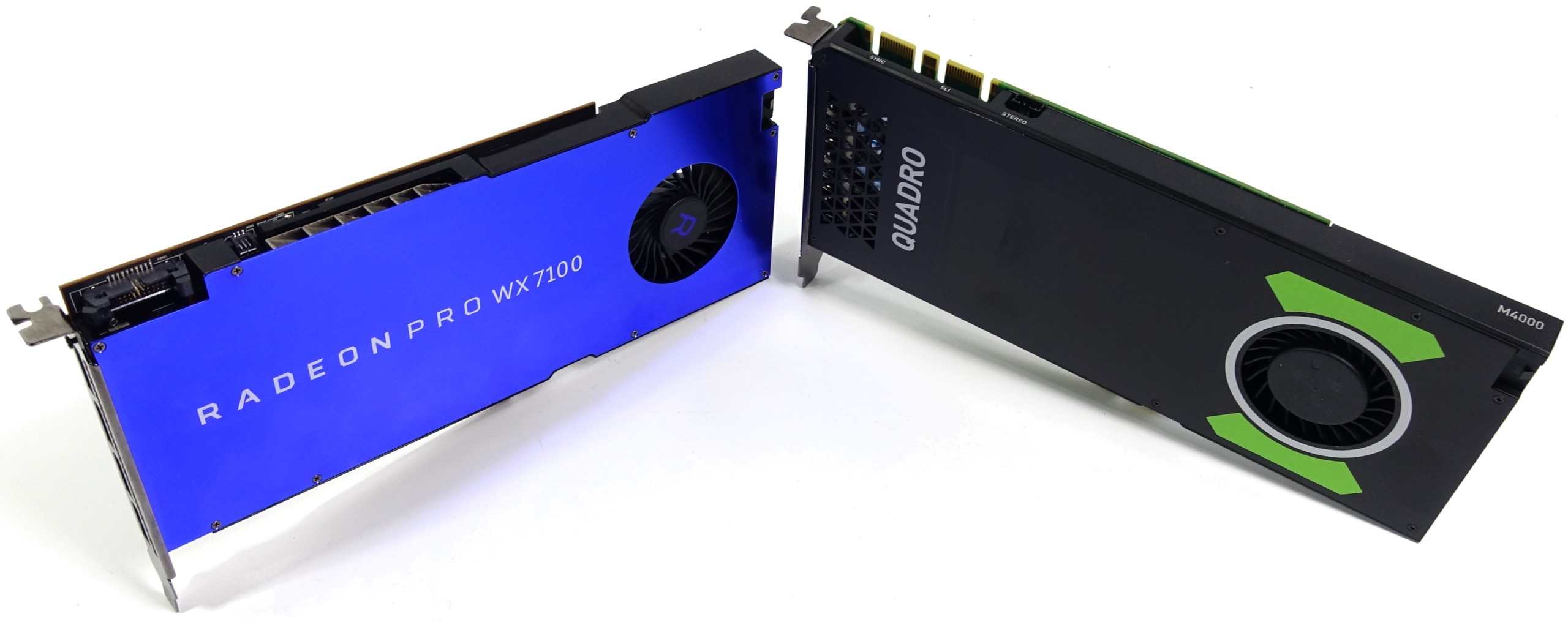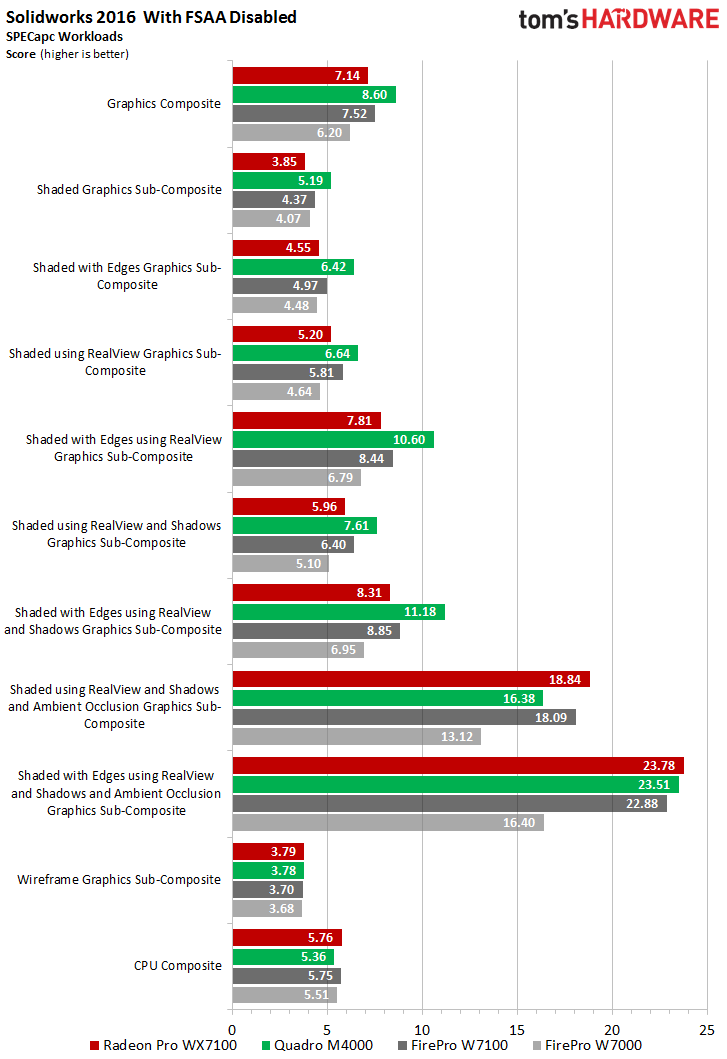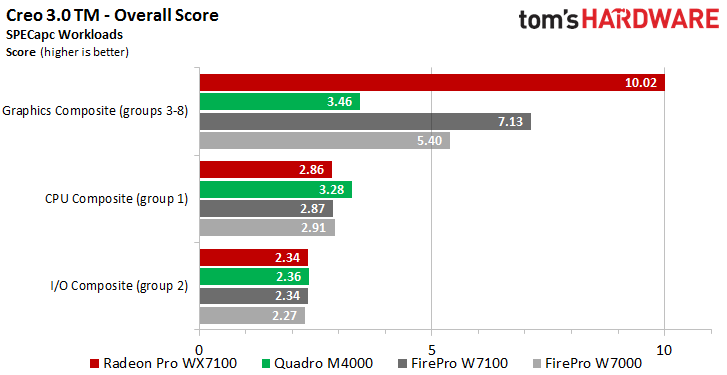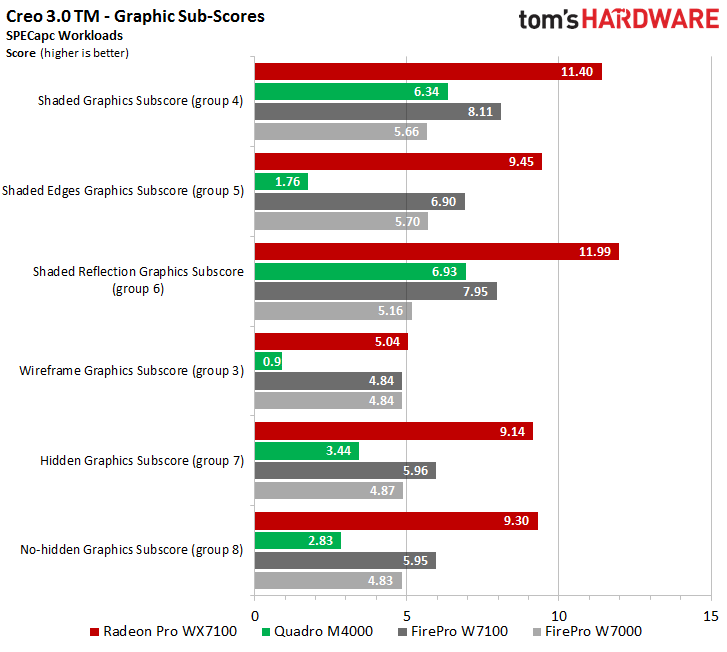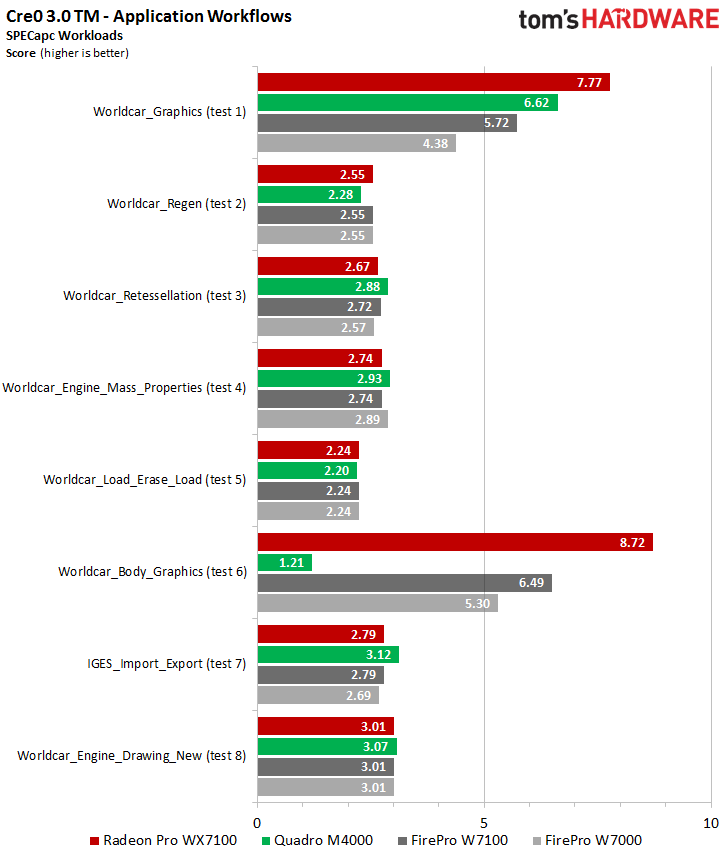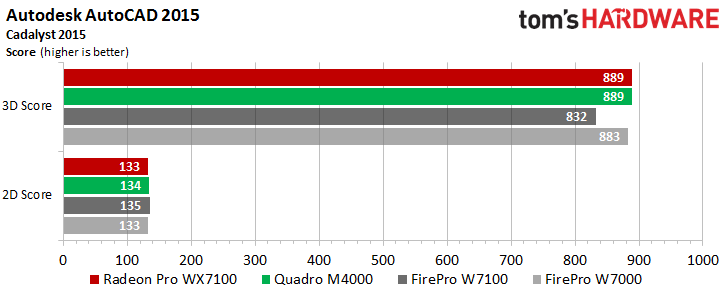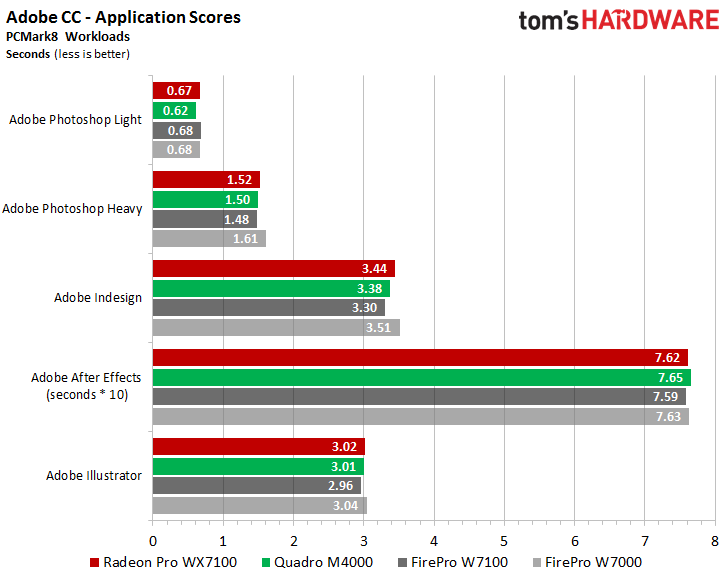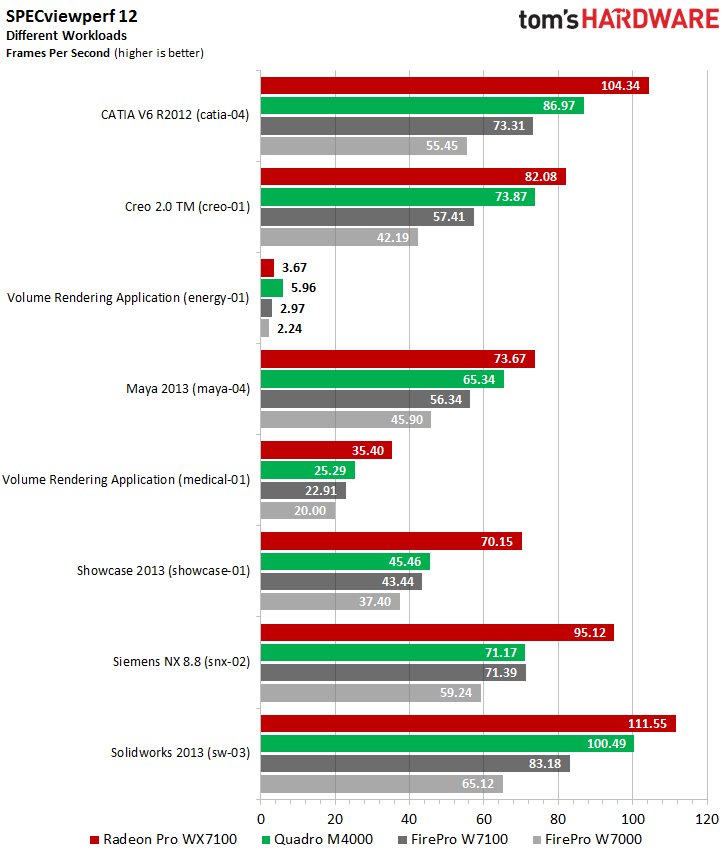AMD Radeon Pro WX 7100 Review
The FirePro brand is dead; long live the Radeon Pro. AMD puts its Polaris chips and reworked drivers to work in three new workstation graphics cards. We’re about to give the fastest model, the Radeon Pro WX 7100, a real workout.
Performance Benchmarks
It's time to explore performance using a number of real-world applications and just a handful of synthetics. Our suite chews up nearly 11 hours per card, since we run each test three times. So we limited the field to AMD's Radeon Pro WX 7100, its direct competition, the Quadro M4000, and two previous-gen FirePro cards.
While we've added desktop-class cards in the past, we're not doing that today. If you run software that requires a certified graphics driver, you won't get very far with a Radeon or GeForce since many functions become unavailable. One example is SolidWorks 2016, which we tested both with and without FSAA in the SPECapc workload:
Whether you use anti-aliasing or not, the differences between a Radeon Pro WX 7100 and Quadro M4000 are small. They're mostly apparent in the details, so we're listing all of the sub-scores.
In Creo 3.0, the Quadro M4000’s dismal results become apparent from a look at the Graphics Composite score.
Drilling down to the sub-scores further illuminates Nvidia's trouble areas. This wasn't always the case. Last summer we spent a bunch of time working with AMD to diagnose a problem in Creo 3.0 (starting from version M90, it ran unstably on then-current FirePro cards). Since then, the driver fixed that issue and then some, clearly.
The Application Workflows metric reveals where Nvidia competes (geometry processing) and where it's out-classed (shading/compute performance). Further optimizations appear unnecessary; AMD is successfully exposing its theoretical advantage in this real-world benchmark.
Autodesk's AutoCAD employs DirectX 11 for its graphical interface, and relies heavily on host processing for its calculations. Not surprisingly, the 2D output is more CPU-limited than GPU-constrained. Only the older FirePro W7100 is a bit slower in the 3D test.
Get Tom's Hardware's best news and in-depth reviews, straight to your inbox.
As an aside, desktop-class cards would work fine here so long as you don't need the application's special features.
Cinebench is a synthetic benchmark that shines a spotlight on OpenGL-based performance. The Radeon Pro WX 7100 wins of course, but it's always amazing to see the performance Nvidia can extract from its weaker Quadro M4000. This is especially true compared to the previous-gen FirePro W7100 and 7000.
Since we’re often asked whether a professional graphics card is needed for Adobe's Creative Cloud, we're also including a score from PCMark 8. Aside from a handful of hardware-accelerated filters or plug-ins, the answer is almost certainly no, since these numbers reflect a host processing bottleneck that keeps all four contenders close to each other.
This relative balance is reflected in the individual application results, which compose the overall score.
SPECviewperf 12 is based on real-world tasks, but it's somewhat synthetic because uncertainties and unpredictable workloads are excluded. AMD and Nvidia each spend a lot of time optimizing their drivers for it, so we're always skeptical of the tool's results.
It looks like AMD's driver team put plenty of work into optimizing ahead of the Radeon Pro WX 7100's launch, at least according to our real-world and synthetic benchmark choices. Not only did they act upon our feedback in Creo 3.0, but they also solved more recent issues with SolidWorks and FSAA. These issues are now in the past.
Current page: Performance Benchmarks
Prev Page Inside The Radeon Pro WX 7100 Next Page Power Consumption
Igor Wallossek wrote a wide variety of hardware articles for Tom's Hardware, with a strong focus on technical analysis and in-depth reviews. His contributions have spanned a broad spectrum of PC components, including GPUs, CPUs, workstations, and PC builds. His insightful articles provide readers with detailed knowledge to make informed decisions in the ever-evolving tech landscape
-
xenol Why can't cards of this design make it to the consumer market? I'm sure there are lots of people yearning for a single-slot cooler card.Reply
On that note, it's ridiculous that AIBs slap on a two-slot cooler on lower end cards. -
Rookie_MIB The reason why it's single slot is simple enough, when you're looking to cram as much compute performance as possible in a computer, the slot spacing matters. There are some workstations which are ATX based which have 7 PCIe x 16 (or x8 after PLX switching) capable slots. As long as the cards can reliably remain below their temp threshold - that's all that matters.Reply
With a gaming style cooler (dual slot) it reduces the amount of compute performance without really increasing the speed as much. For example. If with a dual slot cooler, you can increase the core/VRAM speed 25-50% (because power usage increases exponentially with speed), that doesn't compare with being able to increase the compute by 100% by adding a second card. -
SliSpitfire 3.5 dB(A) more IS actually more than twice the perceived noise (logarithmic scale).Reply -
Virtual_Singularity Thanks for the review. They're a great value for their price. One of the biggest changes at AMD since last year, and especially within the past 6 months or so, has been the increased attention to driver optimization for their dGPUs. Their enterprise-oriented cards also benefit. The coolers on these single slot cards may not be the greatest, but for their intended use they're fine.Reply -
FormatC The price is the best argument. But let's also wait for next Sunday/Monday.Reply
Nvidia will show on their booth (Solidworks World) the new Pascal Quadro lineup.
It's under NDA until next week, but I have the most of this cards already in my hands.
I plan a showdown after this NDA with all available cards from AMD and Nvidia
in real-world applications. I'm sure, the price of the WX7100 will help to survive,
also after the launch :)
The WX4100, 5100 and 7100 are here, also the Quadro P5000, P6000 and a few
not launched cards ;)
BTW:
The Quadro P6000 beats the Titan X Pascal in Gaming. I tried it with Resident Evil 7
in 4K and Shadow Cache On. Impressive, but expensive. :D
The WX7100 is from my sight the better RX480. Closer to the sweet spot and more
efficient. And only marginally slower. The RX480 is the result of the stupid arms race
against the GTX 1060 and might be more interesting without such high clicks/voltages.
Just sitting on a RX480 roundup with up to eight cards and some cards takes more than
200 Watts in gaming loops. This is simply too much for a few FPS more.
Polaris is not bad, if the chips are used as constructed. All stronger OC is mostly painful.
-
shrapnel_indie Reply19247867 said:3.5 dB(A) more IS actually more than twice the perceived noise (logarithmic scale).
Actually, 3 dB isn't perceived as twice as loud. you need 10 dB for that.
http://www.noisehelp.com/decibel-scale.html
http://www.acousticsbydesign.com/acoustics-blog/perception-vs-reality.htm
http://www.siue.edu/~gengel/ece476WebStuff/SPL.pdf (Page 5) -
TJ Hooker Reply
It would be ~twice the power, but human perception of sound is not linear with power.19247867 said:3.5 dB(A) more IS actually more than twice the perceived noise (logarithmic scale). -
bak0n Reply19247750 said:Why can't cards of this design make it to the consumer market? I'm sure there are lots of people yearning for a single-slot cooler card.
On that note, it's ridiculous that AIBs slap on a two-slot cooler on lower end cards.
RX460 is now out as a single slot card. But yes, I agree with you. -
FormatC I like the low-profile cards, because I have a lot of very small ITX-cases with no space inside :)Reply
